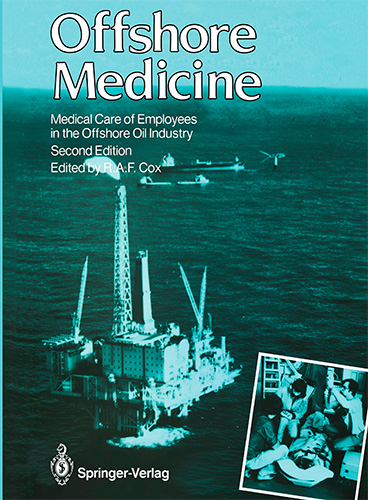Сб с 10 до 16
Offshore Medicine. Medical Care of Employees in the Offshore Oil Industry/Морская медицина. Медицинское обслуживание работников морской нефтяной промышленности
Книга на английском языке
Thirty years' close association with the Oil Industry has been a fascinating and stimulating experience; fascinating because the Oil Industry itself is so full of interest and stimulating because of the challenges which changes in technology have brought about. No longer is oil easily obtainable and no longer can oil be found in exotic regions of the globe. On the contrary, if oil is required it is more likely to be found in the bitter Alaskan ice-fields or in the cold depths of the North Sea, where environments are hostile to man and a challenge to technology. Man's own activities in such hostile environments have created new problems and new hazards. The saga of oil exploration and production in the North Sea has been and continues to be written, but little has been recorded of the hazards inflicted on the men who are faced with the task of implementing this new technology. This book is almost a medical history of the North Sea activities and provides information gained by hard won experience to those involved not only in the North Sea but in any offshore oil operation, wherever it may be.
Contents
1. Introduction (J. Sa’d and R.A.F. Cox)
Geological Exploration
Drilling Rigs
Exploratory Drilling
Development
Production
Communications and Transport
Hazards
Costs of Offshore Operations
Implications for the Doctor
Incidence of Major Mishaps
2. Legal Aspects of Safety, Health and Welfare on the United Kingdom Continental Shelf
The Continental Shelf Doctrine
Territorial Waters, Contiguous Zones and Continental Shelves
The United Kingdom Continental Shelf
Safety, Health and Welfare Legislation on the United Kingdom Continental Shelf
Offshore Installations and Pipelines
Employer’s Liability Insurance Offshore
Summary
References
Schedule of Principal Legislation Governing Safety, Health and Welfare Offshore in Denmark, France, The Netherlands and Norway
3. Pre-placement and Periodic Medical Examinations (R.A.F. Cox)
Pre-placement Examinations
Periodic Examinations
4. Provision of Back-up Services (R. A.F. Cox and J.N. Norman)
Specialist Services
Offshore Disasters
5. Offshore Medical Care (I.K. Anderson and R.A.F. Cox)
Functions of the Offshore Medic
Number and Type of Patients Seen by Medics
Selection and Training of Medics
Medics and Diving
Medical Facilities and Supplies
Stretchers
Mechanical Aids to Respiration
Instruments, Drugs and Dressings
Survival Suits
Communications and Transport
Transporting a Sick or Injured Person
Stand-by Vessels
Medical Selection of Crew
First-Aid Instruction and Training
Medical Equipment for Stand-by Vessels
Supply Vessels
6. Some Special Problems (R.A.F. Cox and J.N. Norman)
Hydrogen Sulphide
Radioactivity
Methane
Methanol
Ethylene Glycol
Obesity
Dust
Drilling Mud
Welding
Noise and Vibration
Trauma
Scabies and Other Infestations
Tropical and Other Endemic Diseases in Immigrants
Psychological Disturbances
Drugs and Alcohol
Partial Drowning and its Treatment
Immediate First Aid
Hypothermia
Treatment
7. Diving (P.B. James and R.A.F. Cox)
Diving Techniques
SCUBA Diving
Surface-Orientated Surface-Supplied Diving
Submersible Decompression Chambers and Deck Chambers
Gases Used in Diving
Air
Mixed Helium and Oxygen (Heliox)
Decompression Techniques
Medical Problems
Ear and Sinus Problems
Other Injuries in the Water or in Chambers
Near-Drowning
Pulmonary Barotrauma
Decompression Sickness
Treatment of Gas Embolism and Decompression Sickness
Air Diving
Mixed Gas Diving
Notes
Immediate Treatment of Decompression Sickness when a
Chamber is not on site
Professional Bodies Associated with Diving
Medical Examination of Divers
Physical Standards
Results of Examination
Return to Diving Following Decompression Sickness and Other
Illnesses
After Type 1 Decompression Sickness
After Type 2 Decompression Sickness
Flying After Diving
Transport of a Patient with Decompression Sickness
Transfer Under Pressure and Hyperbaric Rescue
Sources of Assistance in a Diving Emergency
Long-term Effects of Diving
Drugs Under Pressure
The Use or Misuse of Addictive Drugs
The Incidental Use of Drugs in Diving
The Use of Drugs as Adjuvant Therapy in Decompression Sickness
8. Catering and Hygiene (N. Chalk)
Critical Areas
Food Sources
Containers and Transport
Storage Offshore
Thawing Frozen Foods
Galley Design
Floors and Scuppers
Galley Bulkheads
Ventilation
Food Handlers’ Toilet Facilities
Preparation Surfaces
Catering Machinery (Galley)
Cleaning of Specific Items
Dining Room
Cooks’Tools
Food Handlers
Nutrition Offshore
Routine Health and Hygiene Inspections
9. Dental Problems Offshore (D.J.G. Pyper)
Dental Standards
Dental Jurisprudence
Dental First Aid
Dental Problems in Diving
Dental Treatment
10. Investigation of Fatal and Non-Fatal Accidents (I.M. Calder)
The Fatal Accident
Legal Investigative Aspects
Personnel
Permission
The Non-Fatal Accident
Accident History
Diving Accidents
Causes
Accident Check List
Organisation¬ of Accident Investigation
Recovery, Storage and Preservation of Bodies
Equipment
Role of the Pathologist
Autopsy Technique
Unascertainable Cause of Death
Laboratory Support in Diving Accidents
Transport of Bodies
Return of a Body to the United Kingdom
Export of Bodies from the United Kingdom
Conclusion
Appendices
1. Recommended Drugs and Dressings for Offshore Installation Sick Bays
2. Scale III. The Merchant Shipping (Medical Stores)
Regulations 1986, SI 1986 No. 144
3. Drugs and Medical Equipment to be Kept at Diving Sites
4. Medical Equipment for Use in a Major Disaster
5. Addresses of Committees and Societies Connected with Diving
6. Training Programmes for Offshore Rig Medics and First-Aiders
7. Format for Routine Offshore Hygiene Inspections
8. Health and Safety: Draft, The Offshore Installations and
Pipeline Works (First-Aid) Regulations 1986
9. Extract from Norwegian Regulations Regarding Medical Facilities on Offshore Installations: Royal Decree, 25 November, 1977, Relating to Hygiene, Medical Equipment and Medicines, etc., on Installations for Production, etc., of Submarine Petroleum Resources, etc
10. Control of Noise and Vibration on Offshore Installations (from Offshore Installations: Guidance on Design and Construction. HMSO)
11. First Aid Training of Divers and Diving Supervisors (AODC)
12. The Diving Medical Advisory Committee. Aide-Memoire for Recording and Transmission of Medical Data to Shore (1984)
13. Sources of Assistance in Diving Emergencies
14. Recommended Contents of First-Aid Boxes in Lifeboats and Survival Capsules
15. Recommended Furnishings and Equipment for Use in Hospitals on Offshore Installations
Subject Index




